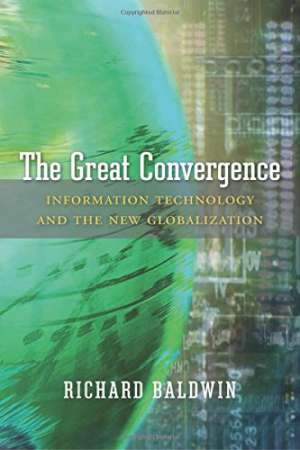02 March 2017
The Great Convergence
Information Technology and the new globalisation
Richard Baldwin
2016, Harvard University Press, 344 pages,
ISBN 978-0674660489
Reviewer: Bridget Rosewell, Volterra Partners

This is an easy-to-read and yet challenging work. Richard Baldwin has been developing his ideas in the area of trade and globalisation for many years and has worked for governments across the globe as well as for think tanks and in academia. His argument is that we are living through the second unbundling of constraints on growth and globalisation. The first was the release of constraints on moving goods, which was made possible by the steam engine and the electric motor. The second is the release of the constraint on moving ideas, which has been made possible by the advent of mobile communication and the internet. We have yet to release his third constraint which is on the movement of people, though ‘real’ virtual reality might perhaps achieve this in due course.
The book includes engaging anecdote as well as charts and statistics, although the charts are perhaps its weakest link. Too often, they are accompanied by a copious note which breaks the flow of the argument rather than enhancing it. Some charts I puzzled over until I gave up. Personally I didn’t find the illustrative drawings particularly helpful either, but I’m perfectly prepared to accept that is because I have been trained to absorb tables and statistics and that others might react quite differently. While the story of the unbundlings is clear and consistent, they are also divided into phases and it was a while before I realised that these matched a first ‘bundling’ phase – agriculture – while the following phases are the unbundling globalisation phases. Within the phases there are also Acts as in a play. I’m not sure that helped.
Baldwin argues that the phases are also associated with different kinds of development. The first unbundling went with the rise of maritime trade and concentrations of economic activity and productivity growth in the Western nations. This, he argues, is Ricardian comparative advantage territory and our analysis has yet to come to terms with the change in how trade works in the second unbundling.
The ability to move ideas rewrites the theory of comparative advantage into one of capabilities and activities or functions rather than a theory of product. It has enabled division of labour to move into a different phase, where any product can be broken down into a whole set of components made in different places, and the services associated with its manufacture can also be disaggregated. He argues that we still need to develop theories to support this, though he mentions the new economic geography as a step in this direction.
The work of Anthony Venables and Paul Krugman would support both this and new trade theory. Baldwin takes this into a description of how countries have beenfited from this second unbundling. He identifies the ‘Rising Eleven’ whose rising shares accounted for fourteen of the seventeen percentage points of lost global GDP share by the G7. They are China, India, Brazil, Indonesia, Nigeria, Korea, Australia, Mexico, Venezuela, Poland and Turkey. These were the most successful in taking advantage of bilateral investment treaties which proliferated from the late 1980s. In doing so, they created a successful virtuous circle in attracting further investment, skills and capabilities.
The changing nature of product and service delivery raises a question which Baldwin defines as ‘how policy can ensure that global value chain participation benefits the domestic economy as a whole?’ He admits he does not have the answers. This question of course has been at the heart of development policies since we had them. Even within advanced economies the challenge of creating embedding linkages from incoming investors has plagued regional policy. ‘Screwdriver’ plants may stay while they are subsidised but disappear quickly when the subsidy stops unless their supply chains have also become more localised. So the tension between the disaggregation of a supply chain and its localisation still remains. Jaguar Land Rover wants to find development land close by its plant for its suppliers so that they can help the innovation process and develop skills. Other producers may well take a different approach.
This book is well worth reading for its wide scope and its long perspective. That is also why it does not have definitive answers – they don’t exist. If it also gives us a healthy dose of humility as policy makers that is no bad thing either.
